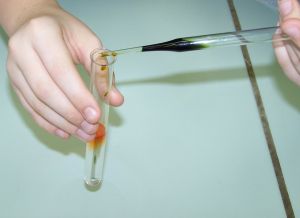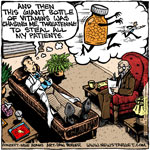A Vitamin D Test Can Reveal Vitamin D Insufficiency
| Share on Facebook | Share on Twitter | Share on Google+ |
Vitamin D insufficiency takes a long time to manifest itself. You can be vitamin D deficient for years or even decades before you have to deal with brittle bones, atherosclerosis, colon cancer, breast cancer, and even skin cancer aggravated by not getting enough of the sunshine nutrient. But don't wait until it's too late before you find out whether you need to supplement. It's easy to test for vitamin D insufficiency. It's important to test long before you "need to."
All that has to be done to measure your vitamin D levels is for the lab to run a simple blood test. Interpreting that blood test, however, is tricky, because if you are vitamin D deficient, one of the kinds of vitamin D will be low but the other kind of vitamin D may be normal. And since many doctors do not know which kind of vitamin D to test, you could be told you have normal levels when actually your vitamin levels are low. Here is the important distinction:
- The right blood test to determine your vitamin D status is 25 (OH) vitamin D, also known as 25-hydroxy vitamin D.
- The wrong blood test to determine your vitamin D status is 1,25 (OH)2 vitamin D, also known as 1,25-dihydroxy vitamin D.
The Importance of Taking the Right Vitamin D Test
Why is choosing the right blood test so important to determining whether or not you suffer vitamin D insufficiency?
- 25-hydroxy vitamin D stays in your bloodstream about 12 weeks. 1,25-dihydroxy vitamin D stays in your bloodstream about 2 days. The first kind of vitamin D tells a lot more about your long-term vitamin status.
- When your vitamin D levels start to fall, your parathyroid glands (tiny glands on the side of your thyroid) increase the conversion of 25-hydroxy vitamin D into 1,25-dihydroxy vitamin D. Measuring 25-hydroxy vitamin D levels gives you an earlier warning of vitamin deficiency.
Choosing the right vitamin D test is critical when doctors are deciding whether to test for tumors and other abnormalities of the parathyroid glands, which happens with surprising frequency in women over 60. Consider the case of Penny, who came in to the doctors with high blood pressure, arthritis, and hearing loss, all of which are affected by vitamin D.
Penny's doctor immediately suspected the problem might lie in the parathyroid glands, so she ordered a test for parathyroid hormone. The test came back with a parathyroid hormone level of 844 pg/ml. (The unit pg refers to picograms, or trillionths of a gram. There are only very, very tiny amounts of this hormone in the body, and only very, very tiny amounts of the hormone are needed.)
A normal parathyroid hormone level is 12 to 50 pg/ml. This lab result indicates the parathyroid gland is working very hard. Could it be a tumor?
Testing Vitamin D Before Taking Drastic Medical Measures
Before taking drastic measures, however, the doctor also ordered two vitamin D tests. The first test was for 1,25-dihydroxy vitamin D. Penny's level was 75 pg/ml. (The unit ng again refers to picograms, or trillionths of a gram. Vitamin D is also found only in very, very small concentrations in the bloodstream.) This level was actually a little high, since the normal range is 12 to 55. Had the doctor stopped there, she might have been looking for cancer of some kind.
But Penny's doctor knew her vitamin D. The doctor also ordered a test for 25-hydroxy vitamin D. This test came back with a reading of just 3 ng/ml. (Here the measurement ng is nanograms, or billionths of a gram. Like the other form of vitamin D, this form is found in only tiny amounts, although there is a thousand times as much as the other kind.)
For 25-hydroxy vitamin D, the normal range is 30 to 100 ng/ml. Penny was extremely deficient in the kind of vitamin D that we get from sunlight or food, before it is processed by the liver.
This meant two things:
- Penny's parathyroid glands were working overtime to try to get every last bit of vitamin D converted to the active form that they could, and
- The problem was a vitamin deficiency, not an endocrine imbalance or cancer.
Days of testing and nights of worry were avoided just by knowing the right test!
Pitfalls of Testing for Vitamin D Insufficiency
Even when doctors know the different kinds of vitamin D, there can be problems interpreting your tests. Many laboratories provide "normal" ranges that are based on what children in the 1930's needed to avoid coming down rickets. As little as 10 ng/dl of 25-hydroxy vitamin D is enough to prevent rickets. (If you get your testing outside the English speaking world, the lab may use a different unit called nmol/L. For this unit, the minimum number is 25 nmol/L.) That's not enough, however, to prevent the problems of aging.
Your doctor probably should be looking for a vitamin D level of 50 ng/dl (or 125 nmol/L) or even higher. If all the doctor looks at is the "NORMAL" printed out by the test and he or she doesn't look at the actual number, the doctor may fail to diagnose your vitamin D insufficiency.
All this information about the types of vitamin D and the ways it is measured can get confusing, even for health professionals. Don't be afraid to print out this page and take it with you to the doctor when you get your results.
Selected References:
Ford, Loretta; Graham, Valerie; Wall, Alan; Berg, Jonathan (2006).
Vitamin D concentrations in an UK inner-city multicultural outpatient population. Annals of Clinical Biochemistry (The Royal Society of Medicine Press Ltd) 43 (6):
Signorello, LB; Williams, SM; Zheng, W; Smith, JR; Long, J; Cai, Q; Hargreaves, MK; Hollis, BW et al. (2010).
Blood vitamin d levels in relation to genetic estimation of African ancestry. Cancer epidemiology, biomarkers & prevention : a publication of the American Association for Cancer Research, cosponsored by the American Society of Preventive Oncology 19 (9): 2325–31.
-
Skin CareMen Skin Care
-
Free ResourcesFree eBooks
-
Let food be thy medicine, and let thy medicine be food.Hippocrates
-
Featured Health Supplement
 The restoration and maintenance of normal organ and brain function and a strong immune system is the key to vibrant health and in
avoiding premature-aging!
The restoration and maintenance of normal organ and brain function and a strong immune system is the key to vibrant health and in
avoiding premature-aging!
-



















